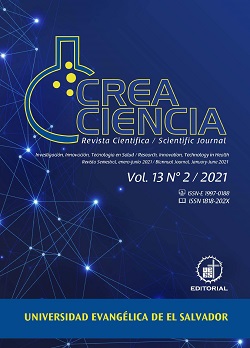parasitic prevalence in water sources from río chagres communities 2010-2019
DOI:
https://doi.org/10.5377/creaciencia.v13i2.11752Keywords:
Intestinal parasites, indigenous communities, prevalence, parasites in water, PanamaAbstract
Indigenous and rural communities live on the banks of the Chagres River, lacking safe water for their consumption, for which they have suffered for years from gastrointestinal diseases that affect their development. To demonstrate the socioeconomic inequality existing in the Capital of Panama, we decided to establish the purpose of this work to know the prevalence of parasites in the waters of the Chagres River used for human consumption. Therefore, we collected 10 L of the water that is consumed by the indigenous communities, in 10 spots for the indigenous communities around AChPP & AChT and in 15 spots for the rural communities in AChVL. The results found reveal that 67% of river waters and 24% of aqueduct waters have parasites (p = 0.11886). In addition, we observe that the two indigenous communities have a 40% parasite prevalence compared to 21% of the rural community (p = 1.00). The study confirms the need to improve water quality in these three communities of the Chagres River.
Downloads
900
Downloads
Published
How to Cite
Issue
Section
License
© Crea Ciencia
Declaration of originality and assignment of rights
The article must be sent with a declaration of originality, responsibility and assignment of rights of copy of the manuscript, scanned and signed by the author or by one of the authors when the authorship is collective (designated author), stating that the text has not previously published in printed or electronic format, which will not be presented to any other media before knowing the decision of the journal Crea Ciencia and that, if accepted for publication, the authors transfer the copyrights in all forms and media known. At the end of six months of the publication, the text can be shared in another magazine citing the first version of the article published in Crea Ciencia and recording its number and volume. If the article is not published, the UEES agrees to return the rights enunciated to their authors.

Crea Ciencia articles are published in open access and licensed under a Creative Commons Attribution-NonCommercial 4.0 International License.

